2017 Peugeot Partner spare wheel
[x] Cancel search: spare wheelPage 7 of 260
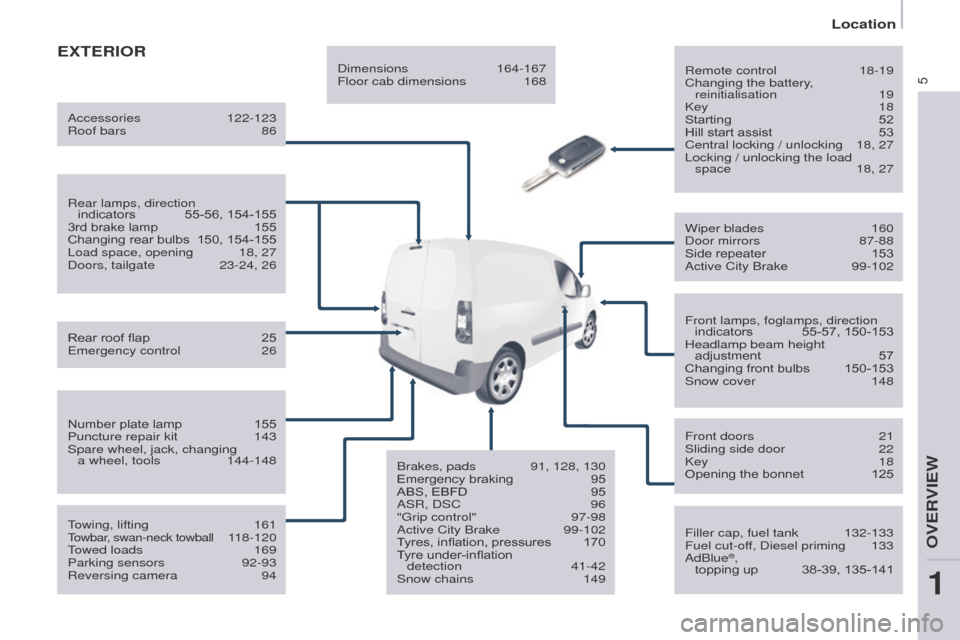
5
Location
Partner-2-VU_en_Chap01_vue-ensemble_ed02-2016
ExTERIOR
Remote control 18-19
Changing the battery ,
reinitialisation
19
Key
18
Starting
52
Hill start assist
53
Central locking / unlocking
18, 27
Locking / unlocking the load
space
18, 27
Filler cap, fuel tank
132-133
Fuel cut-of
f, Diesel priming
133
AdBlue®,
topping up 38-39, 135-141
Wiper blades
160
Door mirrors
87-88
Side repeater
153
Active City Brake
99-102
Front lamps, foglamps, direction indicators
55-57, 150-153
Headlamp beam height adjustment
57
Changing front bulbs
150-153
Snow cover
148
Front doors
21
Sliding side door
22
Key
18
Opening the bonnet
125
T
owing, lifting
161Towbar, swan-neck towball 118-120
T
owed loads
169
Parking sensors
92-93
Reversing camera
94
Number plate lamp
155
Puncture repair kit
143
Spare wheel, jack, changing a
wheel, tools
144-148
Rear lamps, direction
indicators
55-56, 154-155
3rd brake lamp
155
Changing rear bulbs
150, 154-155
Load space, opening
18, 27
Doors, tailgate
23-24, 26
Accessories
122-123
Roof bars
86
Rear roof flap
25
Emergency control
26 Dimensions
164-167
Floor cab dimensions
168
Brakes, pads
91, 128, 130
Emergency braking
95
ABS, EBFD
95
ASR, DSC
96
"Grip control"
97-98
Active City Brake
99-102
T yres, inflation, pressures 170
T
yre under-inflation detection
41-42
Snow chains
149
1
OVERVIEW
Page 8 of 260
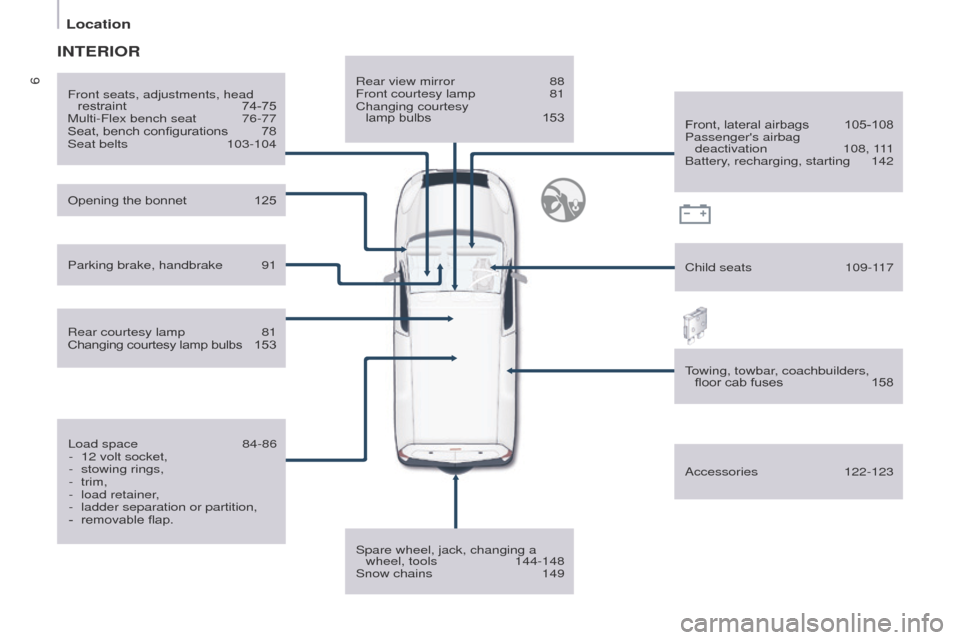
6
Location
Partner-2-VU_en_Chap01_vue-ensemble_ed02-2016
Rear view mirror 88
Front courtesy lamp 81
Changing courtesy
lamp bulbs
153
Spare wheel, jack, changing a wheel, tools
144-148
Snow chains
149 Front, lateral airbags
105-108
Passenger's airbag
deactivation
108, 1
11
Battery, recharging, starting
142
Opening the bonnet
125
T
owing, towbar, coachbuilders, floor cab fuses
158
Front seats, adjustments, head
restraint
74-75
Multi-Flex bench seat
76-77
Seat, bench configurations
78
Seat belts
103-104
INTERIOR
Rear courtesy lamp 81
Changing courtesy lamp bulbs 1 53
Load space
84-86
-
12 volt socket,
-
stowing rings,
-
trim,
-
load retainer
,
-
ladder separation or partition,
-
removable flap. Child seats
109-1
17
Parking brake, handbrake
91
Accessories
122-123
Page 9 of 260
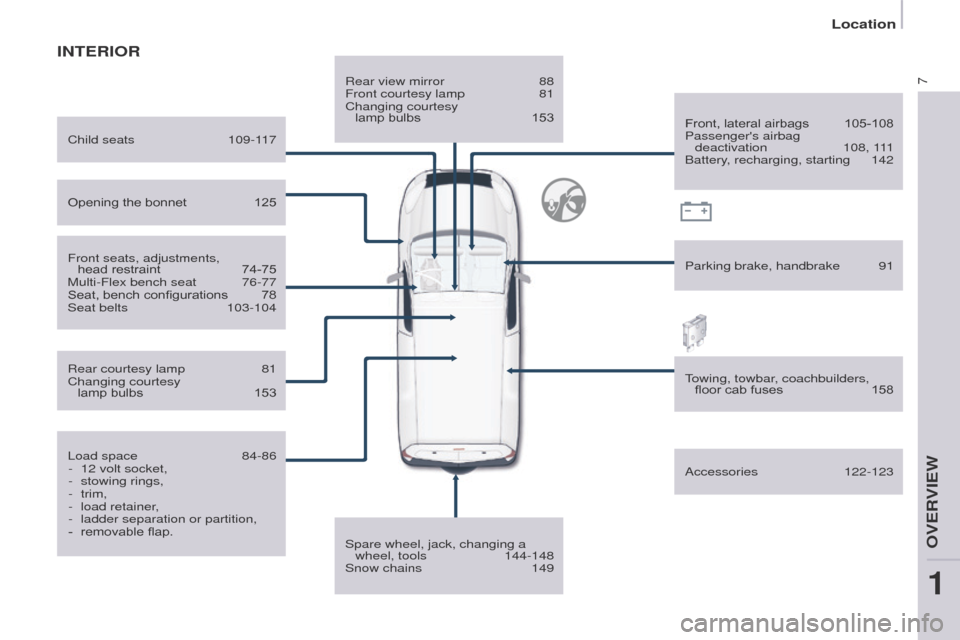
7
Location
Partner-2-VU_en_Chap01_vue-ensemble_ed02-2016
INTERIOR
Rear view mirror 88
Front courtesy lamp 81
Changing courtesy
lamp bulbs
153
Spare wheel, jack, changing a wheel, tools
144-148
Snow chains
149 Front, lateral airbags
105-108
Passenger's airbag
deactivation
108, 1
11
Battery, recharging, starting
142
Child seats
109-1
17
Parking brake, handbrake
91
Front seats, adjustments,
head
restraint
74-75
Multi-Flex bench seat
76-77
Seat, bench configurations
78
Seat belts
103-104 Accessories
122-123
Rear courtesy lamp
81
Changing courtesy
lamp bulbs
153
Load space
84-86
-
12 volt socket,
-
stowing rings,
-
trim,
-
load retainer
,
-
ladder separation or partition,
-
removable flap.
Opening the bonnet
125
T
owing, towbar, coachbuilders, floor cab fuses
158
1
OVERVIEW
Page 19 of 260
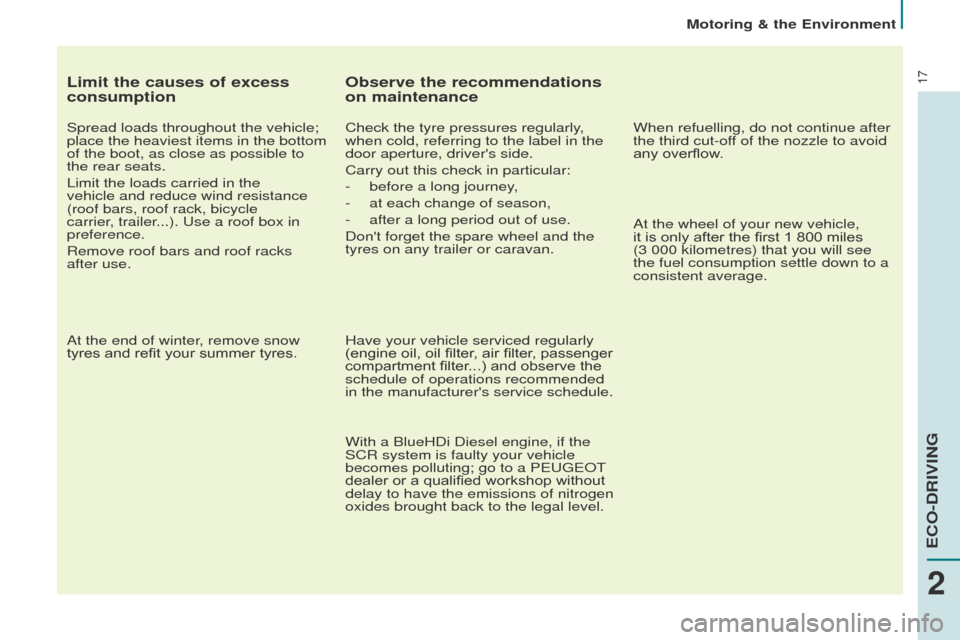
17
Motoring & the Environment
Partner-2-VU_en_Chap02_eco-conduite_ed02-2016
Limit the causes of excess
consumption
Spread loads throughout the vehicle;
place the heaviest items in the bottom
of the boot, as close as possible to
the rear seats.
Limit the loads carried in the
vehicle and reduce wind resistance
(roof bars, roof rack, bicycle
carrier, trailer...). Use a roof box in
preference.
Remove roof bars and roof racks
after use.
At the end of winter, remove snow
tyres and refit your summer tyres.
Observe the recommendations
on maintenance
Check the tyre pressures regularly,
when cold, referring to the label in the
door aperture, driver's side.
Carry out this check in particular:
-
before a long journey
,
-
at each change of season,
-
after a long period out of use.
Don't forget the spare wheel and the
tyres on any trailer or caravan.
Have your vehicle serviced regularly
(engine oil, oil filter
, air filter, passenger
compartment filter...) and observe the
schedule of operations recommended
in the manufacturer's service schedule.
With a BlueHDi Diesel engine, if the
SCR system is faulty your vehicle
becomes polluting; go to a PEUGEOT
dealer or a qualified workshop without
delay to have the emissions of nitrogen
oxides brought back to the legal level. When refuelling, do not continue after
the third cut-off of the nozzle to avoid
any overflow.
At the wheel of your new vehicle,
it is only after the first 1 800 miles
(3
000 kilometres) that you will see
the fuel consumption settle down to a
consistent average.
2
ECO-DRIVING
Page 43 of 260
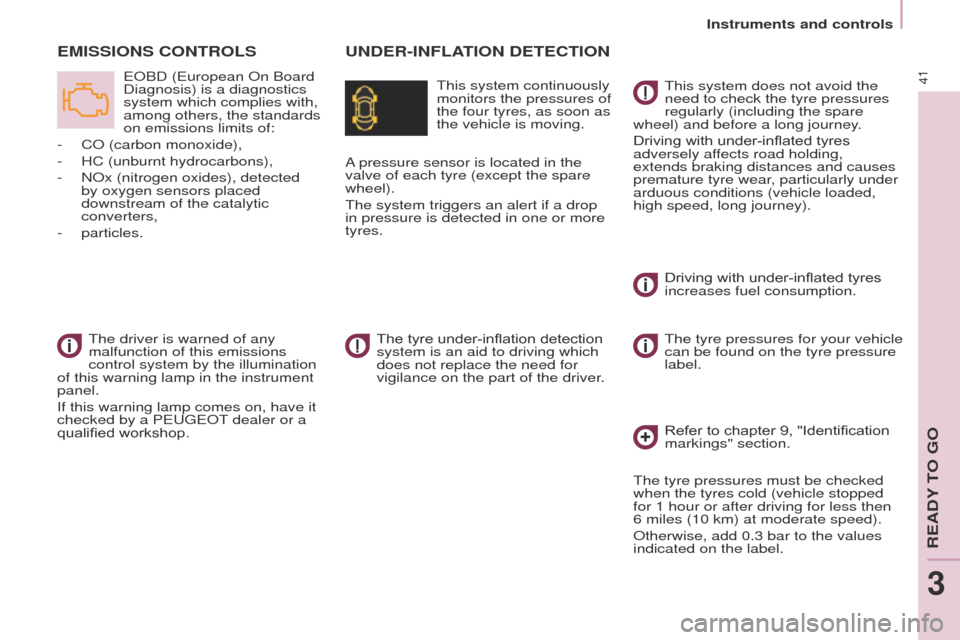
41
Partner-2-VU_en_Chap03_Pret-a-partir_ed02-2016
Instruments and controls
UNDER-INFLATION DETECTIONE
MISSIONS
CONTROLS
This system continuously
monitors the pressures of
the four tyres, as soon as
the vehicle is moving.
EOBD (European On Board
Diagnosis) is a diagnostics
system which complies with,
among others, the standards
on emissions limits of:
-
CO (carbon monoxide),
-
HC (unburnt hydrocarbons),
-
NOx (nitrogen oxides), detected
by oxygen sensors placed
downstream of the catalytic
converters,
-
particles. A
pressure sensor is located in the
valve of each tyre (except the spare
wheel).
The system triggers an alert if a drop
in pressure is detected in one or more
tyres.
The tyre under-inflation detection
system is an aid to driving which
does not replace the need for
vigilance on the part of the driver. This system does not avoid the
need to check the tyre pressures
regularly (including the spare
wheel) and before a long journey.
Driving with under-inflated tyres
adversely affects road holding,
extends braking distances and causes
premature tyre wear, particularly under
arduous conditions (vehicle loaded,
high speed, long journey).
Driving with under-inflated tyres
increases fuel consumption.
The tyre pressures for your vehicle
can be found on the tyre pressure
label.
Refer to chapter 9, "Identification
markings" section.
The tyre pressures must be checked
when the tyres cold (vehicle stopped
for 1 hour or after driving for less then
6 miles (10 km) at moderate speed).
Otherwise, add 0.3 bar to the values
indicated on the label.
The driver is warned of any
malfunction of this emissions
control system by the illumination
of this warning lamp in the instrument
panel.
If this warning lamp comes on, have it
checked by a PEUGEOT dealer or a
qualified workshop.
READY TO GO
3
Page 44 of 260
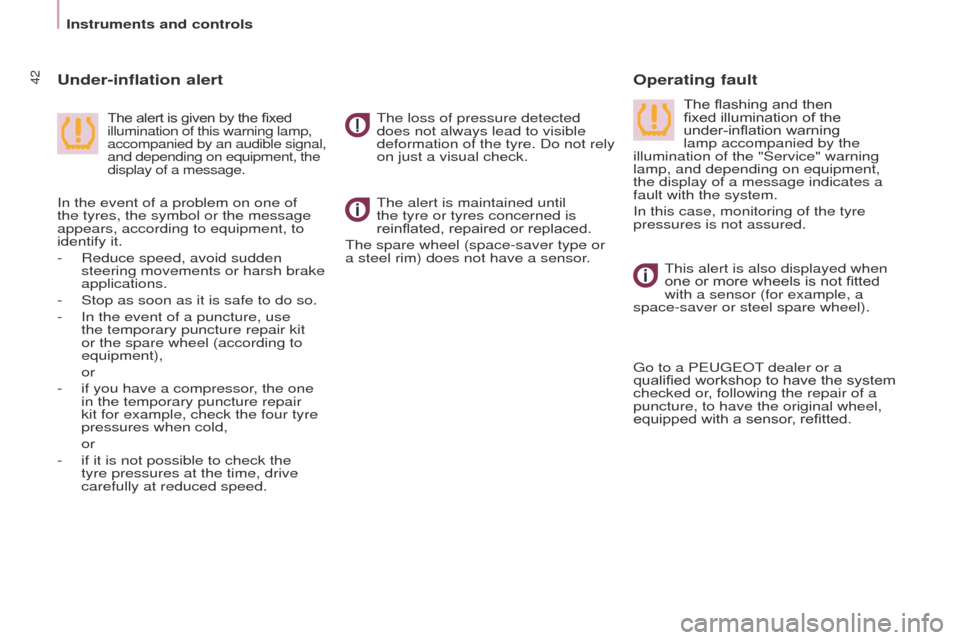
42
Partner-2-VU_en_Chap03_Pret-a-partir_ed02-2016
Instruments and controlsThe alert is maintained until
the tyre or tyres concerned is
reinflated, repaired or replaced.
The spare wheel (space-saver type or
a steel rim) does not have a sensor.
Operating fault
Under-inflation alert
The loss of pressure detected
does not always lead to visible
deformation of the tyre. Do not rely
on just a visual check.The alert is given by the fixed
illumination of this warning lamp,
accompanied by an audible signal,
and depending on equipment, the
display of a message.The flashing and then
fixed illumination of the
under-inflation warning
lamp accompanied by the
illumination of the "Service" warning
lamp, and depending on equipment,
the display of a message indicates a
fault with the system.
In this case, monitoring of the tyre
pressures is not assured.
In the event of a problem on one of
the tyres, the symbol or the message
appears, according to equipment, to
identify it.
-
Reduce speed, avoid sudden
steering movements or harsh brake
applications.
-
Stop as soon as it is safe to do so.
-
In the event of a puncture, use
the temporary puncture repair kit
or the spare wheel (according to
equipment),
or
-
if you have a compressor
, the one
in the temporary puncture repair
kit for example, check the four tyre
pressures when cold,
or
-
if it is not possible to check the
tyre pressures at the time, drive
carefully at reduced speed. This alert is also displayed when
one or more wheels is not fitted
with a sensor (for example, a
space-saver or steel spare wheel).
Go to a PEUGEOT
dealer or a
qualified workshop
to have the system
checked or, following the repair of a
puncture, to have the original wheel,
equipped with a sensor, refitted.
Page 145 of 260
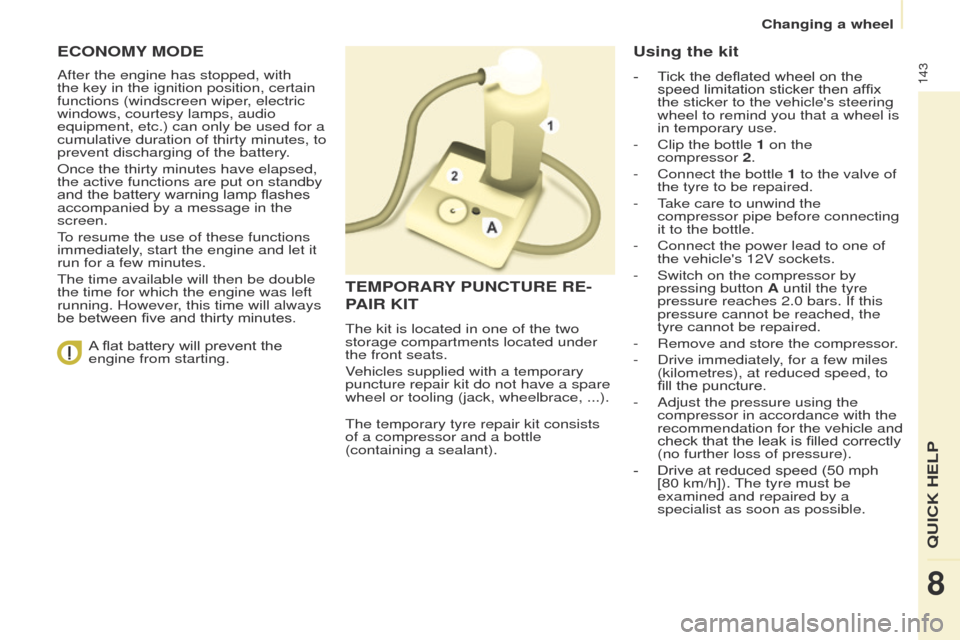
143
Partner-2-VU_en_Chap08_Aide-rapide_ed02-2016
ECONOMY MODE
After the engine has stopped, with
the key in the ignition position, certain
functions (windscreen wiper, electric
windows, courtesy lamps, audio
equipment, etc.) can only be used for a
cumulative duration of thirty minutes, to
prevent discharging of the battery.
Once the thirty minutes have elapsed,
the active functions are put on standby
and the battery warning lamp flashes
accompanied by a message in the
screen.
To resume the use of these functions
immediately, start the engine and let it
run for a few minutes.
The time available will then be double
the time for which the engine was left
running. However, this time will always
be between five and thirty minutes.
A flat battery will prevent the
engine from starting.
TEMPORARY PUNCTURE RE -
P
AIR KIT
The kit is located in one of the two
storage compartments located under
the front seats.
Vehicles supplied with a temporary
puncture repair kit do not have a spare
wheel or tooling (jack, wheelbrace, ...).
The temporary tyre repair kit consists
of a compressor and a bottle
(containing a sealant).
Using the kit
- Tick the deflated wheel on the speed limitation sticker then affix
the sticker to the vehicle's steering
wheel to remind you that a wheel is
in temporary use.
-
Clip the bottle
1 on the
compressor
2.
-
Connect the bottle
1 to the valve of
the tyre to be repaired.
-
T
ake care to unwind the
compressor pipe before connecting
it to the bottle.
-
Connect the power lead to one of
the vehicle's 12V sockets.
-
Switch on the compressor by
pressing button
A until the tyre
pressure reaches 2.0 bars. If this
pressure cannot be reached, the
tyre cannot be repaired.
-
Remove and store the compressor
.
-
Drive immediately
, for a few miles
(kilometres), at reduced speed, to
fill the puncture.
-
Adjust the pressure using the
compressor in accordance with the
recommendation for the vehicle and
check that the leak is filled correctly
(no further loss of pressure).
-
Drive at reduced speed (50
mph
[80 km/h]). The tyre must be
examined and repaired by a
specialist as soon as possible.
QUICK HELP
8
Changing a wheel
Page 146 of 260
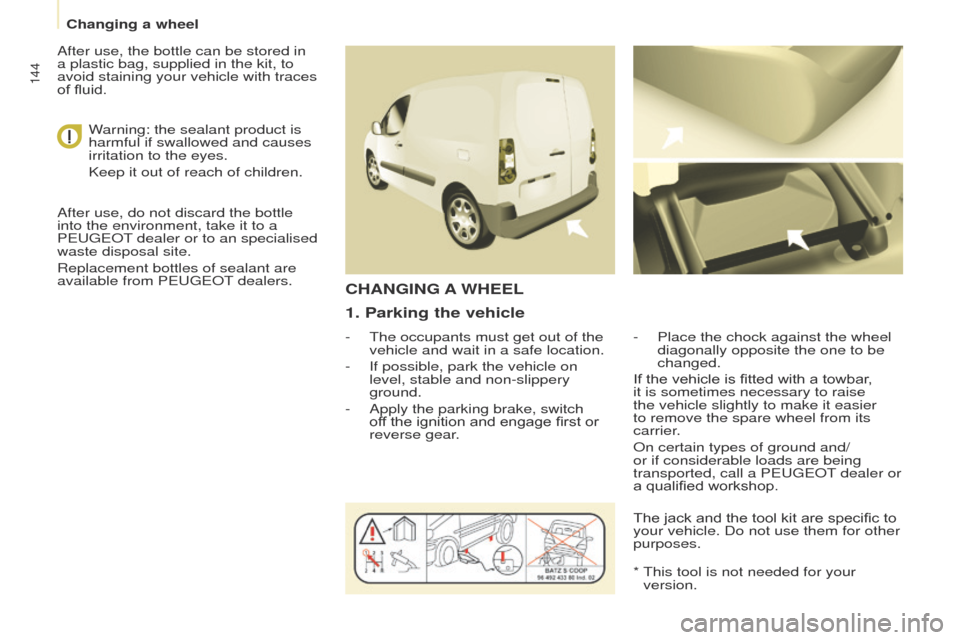
144
Partner-2-VU_en_Chap08_Aide-rapide_ed02-2016
1. Parking the vehicle
- The occupants must get out of the
vehicle and wait in a safe location.
-
If possible, park the vehicle on
level, stable and non-slippery
ground.
-
Apply the parking brake, switch
of
f the ignition and engage first or
reverse gear. -
Place the chock against the wheel
diagonally opposite the one to be
changed.
CHANGING A WHEEL
If the vehicle is fitted with a towbar,
it is sometimes necessary to raise
the vehicle slightly to make it easier
to remove the spare wheel from its
carrier.
On certain types of ground and/
or if considerable loads are being
transported, call a PEUGEOT dealer or
a qualified workshop.
*
This tool is not needed for your
version.
The jack and the tool kit are specific to
your vehicle. Do not use them for other
purposes.
W
arning: the sealant product is
harmful if swallowed and causes
irritation to the eyes.
Keep it out of reach of children.
After use, do not discard the bottle
into the environment, take it to a
PEUGEOT dealer or to an specialised
waste disposal site.
Replacement bottles of sealant are
available from PEUGEOT dealers. After use, the bottle can be stored in
a plastic bag, supplied in the kit, to
avoid staining your vehicle with traces
of fluid.
Changing a wheel